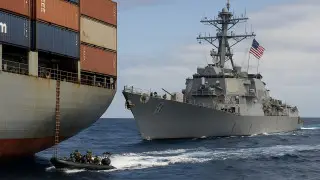
The Quad Summit, which was scheduled to take place in Sydney, has been cancelled. The powerful naval fleets of the United States, India, Australia, and Japan, on the other hand, will take part in the advanced Malabar 2023 drills off Australia’s east coast from August 11 to 22.
The drills are designed to improve interoperability, practise sea deterrence, and protect freedom of navigation in the Indo-Pacific region. The training will include both maritime and harbour stages, during which high-ranking commanders from the Quad navies will address Indo-Pacific issues.
India will send advanced destroyers, P-8I anti-submarine warfare aircraft, and a submarine to the Malabar 2023 exercises, according to logistics agreements with all three Quad countries. The Malabar military drills began in 1992 as a bilateral exercise between India and the US, with Japan becoming a permanent member in 2015 and Australia joining in 2020 to complete the Quad.

The primary focus of the naval exercise, according to officials, will be anti-submarine warfare tasks, as the People’s Liberation Army (PLA) Navy has become more assertive in the Indo-Pacific, making territorial claims in the South China Sea, much to the disappointment of ASEAN countries like the Philippines and Indonesia.
Beijing’s strategic objective is to establish control in the far Pacific by placing warships and submarines across the first and second chains of islands off its eastern shoreline, with the PLA Navy quickly growing its fleet of nuclear-powered conventional armed submarines. Furthermore, to dissuade the US Navy from operating in the South China Sea, China has stationed missile installations along its eastern coast, such as traditional DF-21 missile parks. In addition, threats to employ DF-26 missiles to target US naval and military stations in Guam have been made.
While India, Australia, and the United States are clear about their goals in the Quad and the Indo-Pacific area, the spotlight is on Japan, which is currently debating its posture towards Beijing as a result of major investments made by Japanese corporations in China. Although both Japan and China are nuclear powers, Tokyo would be the first to face a military crisis if President Xi Jinping ordered the PLA to take Taiwan. There are still unsolved difficulties between India and the PLA along the East Ladakh Line of Actual Control (LAC), as the latter has yet to de-escalate and withdraw from the western and eastern sectors, where additional combined military units have been posted. As the Quad meeting is scheduled in Hiroshima, the first city to be the victim of a nuclear bomb, it is anticipated that the alliance will expand and further strengthen in this anti-war city in southern Japan.
The India-US military exercise schedule was reviewed at the 17th meeting of the bilateral defence policy group, where both sides expressed their commitment to strengthening cooperation and interoperability across all domains and services. The meeting, co-chaired by Indian Defence Secretary Giridhar Aramane and Dr Colin Kahl, US Under Secretary for Policy at the Pentagon, focused on shared priorities in the Indian Ocean Region and coordinating the bilateral collaboration with other like-minded countries to preserve a free and open Indo-Pacific. The meeting covered a broad range of issues, including economic cooperation, marine security, and technology collaboration, demonstrating India and the US’s strong and comprehensive connections.













Copyright © 2025 Top Indian News
